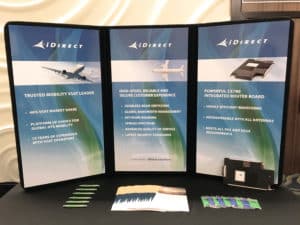
The days of discussion and debate about how airlines can make money from IFC are gone. Today IFC is a requirement in order to remain competitive. In fact, in a recent survey conducted by Inmarsat, 60% of passengers said that Wi-Fi is a necessity onboard a flight. And if the connectivity is poor? The survey reported 44% of passengers would book a different airline next time.
So what makes the Wi-Fi connectivity good enough — and what other applications need to be managed as part of IFC?
It’s important to look at all the various applications that in-flight connectivity provides beyond passenger entertainment and Wi-Fi. That includes increasing communication among crew, cockpit and ground maintenance teams to allow for better predictive aircraft management and reduced repair delays. And it also means equipping cabin crews with the latest mobile technology to improve customer care and increase flight attendant safety.
Satellite operators realize that inconsistency in SLAs/ coverage is a major obstacle to adoption, creating challenges in achieving a good return on investment. According to Mark Richman, Director, Product Management Mobility & Energy Services for Intelsat, one way to overcome this inconsistency is through a combination of three factors: ubiquity, density and resiliency/scalability. Intelsat has achieved this through their HTS EpicNG constellation and their plans for HTS 2.0 – the LEO/GEO integration. According to Andrew Ruszkowski, SES, VP Strategic Initiatives Mobility, the answer to ubiquitous coverage lies with the fact that at the moment SES operates the only operational geo/ non-geo constellation with their integration of O3B.
With all this abundance in capacity and increased connectivity expectations it is becoming increasingly important to manage bandwidth across a contended network that spans multiple beams, aircraft and end users. While the VSAT industry is primarily focused on increasing data throughput rates with higher efficiencies and higher performance such as DVB-S2X, there is much more to the solution. How bandwidth is managed at a network level determines overall quality of QoS across aircraft and maximizes the investment in capacity. Airlines must be equipped to select the best available bandwidth based on different satellites and beams, and dynamically allocate that bandwidth across aircraft and multiple application suites onboard the aircraft.
Inmarsat’s answer to these challenges is their vertically integrated network offering with their GX network and Honeywell as the aviation integrator. Inmarsat designed coverage specifically around the airline routes to offer seamless and consistent transitions based on iDirect technology. In fact, last week on The Today Show, Inmarsat, together with Honeywell, put iDirect’s new CX780 to the test in their GX network and had speeds faster than terrestrial onboard a live flight.
iDirect’s Sef Senhaji, Sr. Director, Aero Mobility, presented on key network requirements to optimize aircraft connectivity; he also highlighted in a previous blog how airlines can harness HTS capacity, improve QoS and bring smarter technology onboard.
With a myriad of complex connectivity choices and decisions, the whole topic of IFC can be daunting for airlines. But with nearly half of today’s passengers ready to switch airlines if the Wi-Fi falls short, the tough decisions have to be made sooner rather than later.
